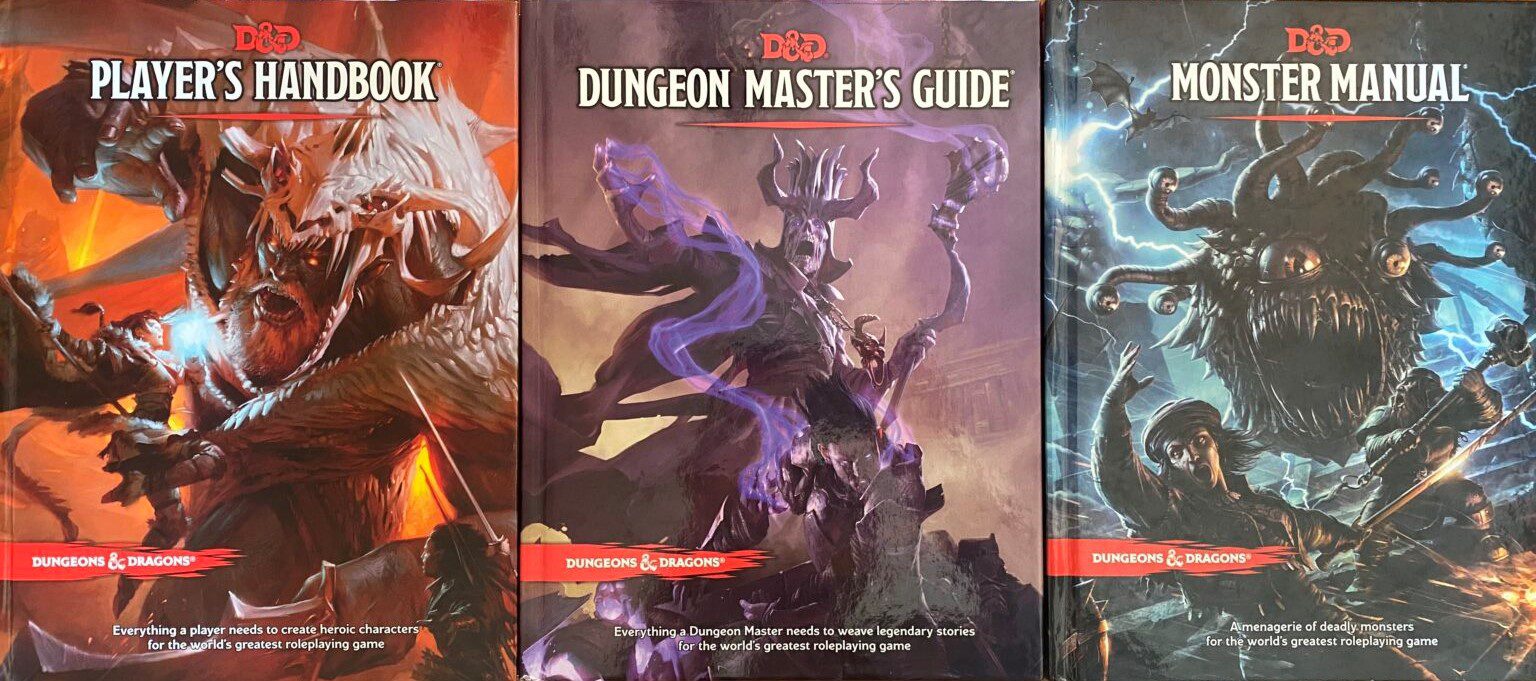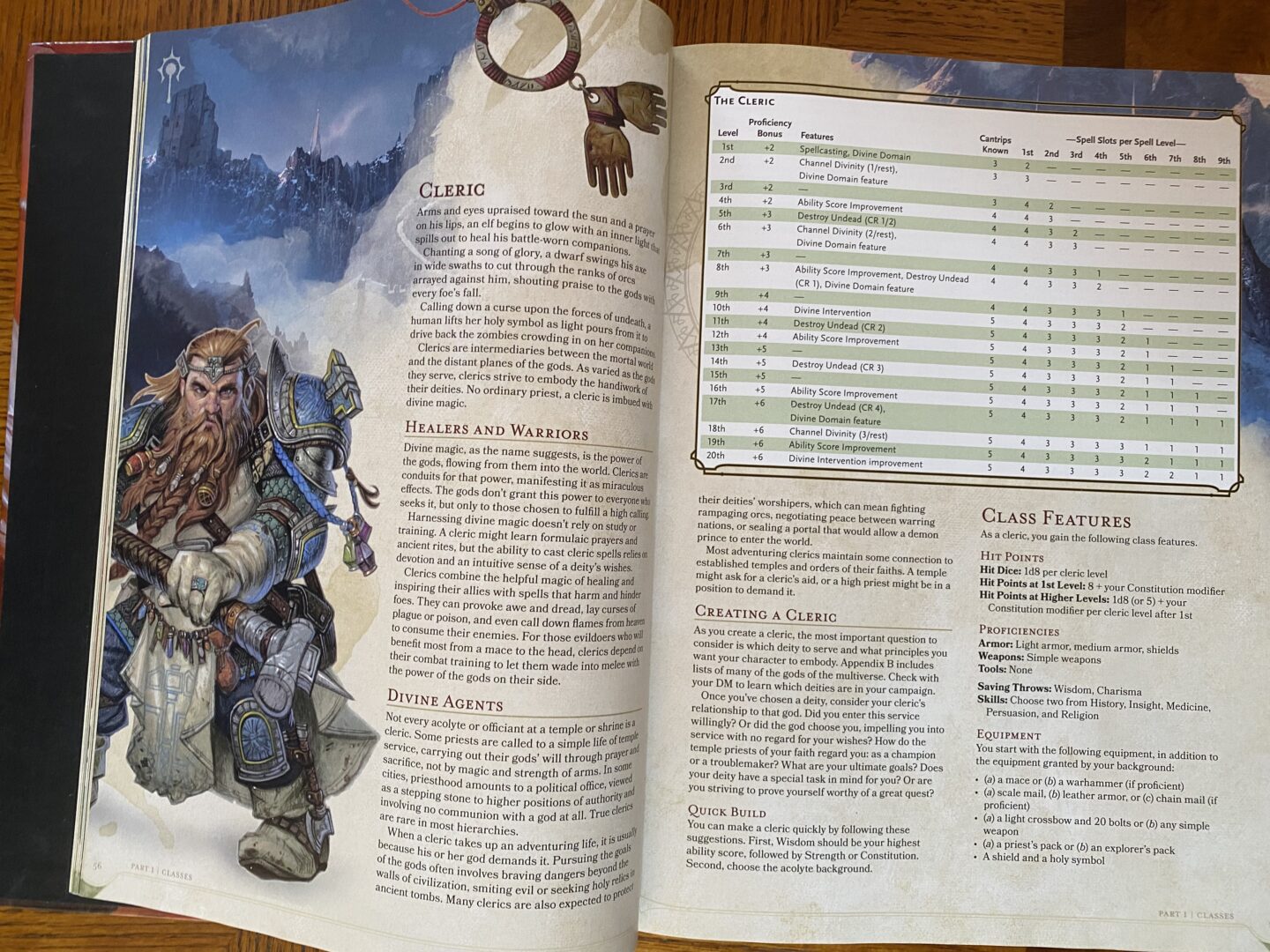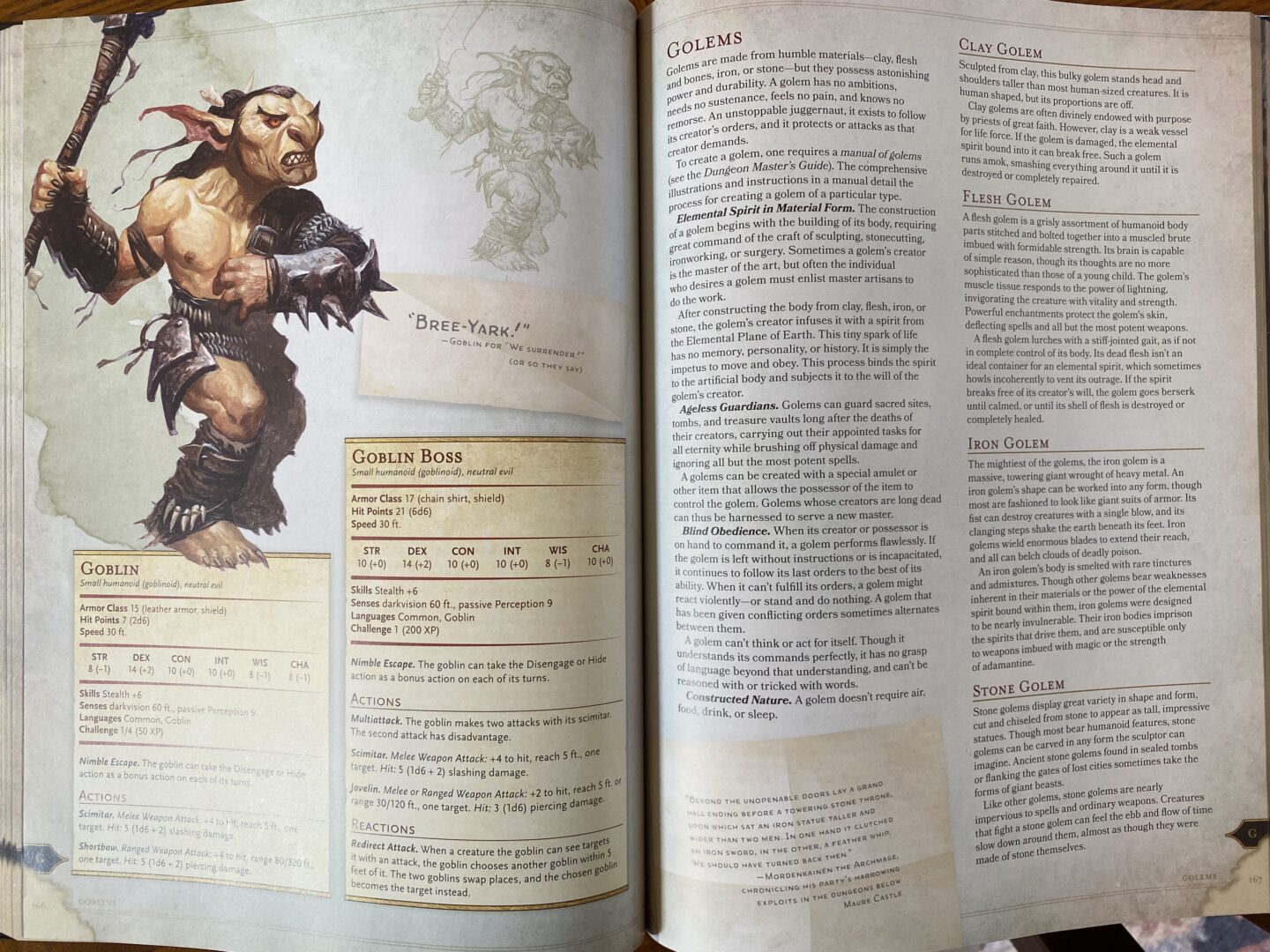In 1974, two game designers by the name of Gary Gygax and Dave Arneson released a wargame that would become a cultural phenomenon and inspire an entirely new genre of tabletop games. Unlike their previous wargames, which were grounded in the history of warfare from Ancient Greece to World War II and everything in between, this game took place in fantastical realms of monsters and magic invoking classic fantasy novels such as J. R. R. Tolkein’s The Lord of the Rings and swords & sorcery pulp fiction like Robert E. Howard’s Conan the Barbarian. The game in question is of course Dungeons & Dragons.
I alluded to the topic of Dungeons & Dragons in my article about the origins of hammer wielding priests in gaming, but we haven’t had a proper review of a D&D product since SwissGuard’s review of Lords of Waterdeep back in 2020! It’s high time we gave the most influential and popular tabletop roleplaying game in the world the full Catholic Game Reviews treatment, a daunting quest I am more than willing to accept. More specifically, I’m going to be covering the core rulebooks of the game’s 5th edition, the Player’s Handbook, the Dungeon Master’s Guide, and the Monster Manual which were all released in 2014. So draw your swords, prepare your spells, and keep a bottle of water and some snacks handy as we begin our adventure.

With covers like these I’m pretty sure this counts as a Spooky Month review right?
Before I dive into the quality of the books, allow me to provide a brief introduction to tabletop roleplaying games as a whole. In a tabletop roleplaying game there is usually a group of 3 to 5 players and 1 referee. The players create characters to interact with a fictional world set up by the referee. Most of the action takes place in the group’s imagination, but important information is tracked using character sheets, notebooks, and other organizational tools. Whenever an action involves a level of uncertainty, dice are rolled to help determine the outcome. Overall the experience is somewhere between a traditional board game and playing make-believe in someone’s backyard. There is far more room for creativity compared to other tabletop games, but the rules provide boundaries to ensure the group doesn’t turn themselves into invincible demi-gods who never fail or suffer consequences.
Now that we’ve established what a roleplaying game is, let’s see what D&D 5E does to this formula. The Player’s Handbook is the most logical starting point as its contents cover the most basic elements of the game. The book begins with character creation which includes ability scores, races, classes, backgrounds, and equipment. Ability scores are divided into 6 categories that measure a character’s physical and mental capabilities which include Strength, Dexterity, Constitution, Intelligence, Wisdom, and Charisma. These 6 ability scores are the foundation for almost everything else in the rules. Attacking an enemy with a sword? Your Strength score affects how much damage you can do with that sword. Looking for a hidden door in a dungeon? Your Wisdom score affects how quickly you’ll find it, or if you find it at all. A character’s race can provide boosts to certain ability scores as well as many other unique abilities specific to that race. Dwarves are really tough, Elves have an affinity for magic, Halflings (also known as copyright free Hobbits) are very sneaky, so on and so forth.
Arguably the most defining choice in the character creation process is the character’s class. Each of the 12 classes are suited for particular roles such as combat, exploration, or magic so the choice can have a huge impact on how the player approaches the game. Additionally, 5E has subclasses within each class that add even more specialized abilities to your character’s arsenal. For example the Fighter is a fairly straightforward combat-oriented class, but with the Eldritch Knight subclass it can learn a few spells from the Wizard to augment its tactical options. In theory all these classes and subclasses should create a lot of unique characters, but in practice I think many of the classes end up stepping on each other’s toes. If they combined some of the classes with similar motifs, such as the Bard, Warlock, Sorcerer, and Wizard into a dedicated Magic-User class, they could have easily cut down the amount of classes to about 5 or 6.

This is my favorite page. Deus Vult!
After race and class the player chooses a background which determines the occupation their character held before becoming an adventurer. Backgrounds mostly exist to give the characters an extra proficiency or two and maybe a handful of flavorful items, but definitely nothing as impactful as the benefits provided by races and classes. Finally there’s equipment. Adventuring is a dangerous profession so characters need weapons, armor, tools, food, and other necessities to stay alive. Starting equipment is determined by class and background, but most of the best items like warhorses and longships will be out of reach. You’ll want to keep this chapter handy in order to upgrade your inventory after you’ve been through a few adventures collecting treasure.
Following character creation, the rest of the Player’s Handbook details the rules surrounding ability checks, adventuring, combat, spellcasting, and all the other fundamentals of the game. I won’t go over everything, but I would like to take this opportunity to address my biggest grievance with 5th Edition. The player characters are way too strong. At 1st level the player characters always start with the highest possible roll on their hit point dice plus their Constitution modifier, meaning even a frail class like the Wizard will routinely start with at least 6 to 8 hit points which is something a sturdier class like the Fighter would have been lucky to start with in older editions where the highest roll was not guaranteed. Additionally, the way ability scores are calculated at 1st level often results in characters with lots of bonuses and very few hindrances. For instance a Human character using the standard array would have an ability spread of +3, +2, +2, +1, +0, and -1 which when utilized properly can turn an average adventurer into a veritable superhero.
All these first level shenanigans are pretty bad, but once you reach fifth level the game breaks wide open. 5th level characters that can utilize spells, such as Clerics, Wizards, and Sorcerers, gain access to incredibly powerful spells like Fireball which can cause massive damage to multiple enemies at once or Revivify which despite a few restrictions can functionally resurrect the dead. I’m not against giving players powerful abilities like this, but 5th level seems way too early given that the maximum level is 20. My other huge complaint is the utilization of the Charisma score in social interactions. For example if the player is negotiating the price of an item with a merchant, they’d make a deception or persuasion roll to determine if they are successful. I consider this counterproductive to a roleplaying game as the player might come up with a clever solution to the problem, only to be undermined by a bad dice roll. Good roleplaying should always be rewarded, not arbitrarily discarded.
Moving on from the Player’s Handbook, the Dungeon Master’s Guide is intended for the referee’s eyes only. The book contains tips on how to create the fictional worlds the game takes place in, powerful magic items used as rewards for overcoming challenges, optional rules for unorthodox adventure scenarios, rules for creating new spells and monsters, and random tables to quickly generate dungeons and encounters on the fly. This book can be quite useful for referees struggling with writer’s block, but aside from the magic items list and unorthodox adventure rules I’d argue it’s not strictly necessary to use when playing the game. A referee with a strong idea of what kind of world they want to make and the adventures they want to present the players probably doesn’t need all those prompts and tables to bring that vision to life.

Need more time to set up a dungeon? Roll up a random town to keep your players occupied for a session or two.
The last book, the Monster Manual, contains premade stat blocks for a large variety of creatures and villains the players are likely to encounter while adventuring. These fearsome foes include everything from orcs, goblins, bandits, giants, dragons, demons, zombies, and a whole host of other creatures you’ve probably never heard of. Unlike the Dungeon Master’s Guide, I think the Monsters Manual is a must buy for referees for the sheer volume of readymade content it provides for the game.
That’s the basic overview of everything you’ll find in these books, but there’s a little secret you might have picked up on as I described the process of creating your character, your world, or your monsters. In many ways the books are more like guidelines than strict rules. The system presented in 5th Edition is surprisingly modular so you can easily change the rules without causing the whole game to collapse in on itself. Earlier I complained that player characters are way too resilient at early levels, but make a few changes to hit points, death saves, and resurrection spells and suddenly death becomes a real threat the players need to consider when making decisions. You can also use the existing rules as a template for new weapons, items, races, classes, subclasses, spells, monsters, or whatever else you might want to add into the game.
This flexibility is the game’s greatest strength, but it also makes recommending the game somewhat difficult. You can change and improve the game as much as you want, but there does come a point where you might change the game so much that you might as well find a different tabletop RPG more suited to your group’s preferences or even create your own game if you happen to be that game-savvy. I know that sounds a bit extreme, but when the game largely takes place in the group’s imagination it really doesn’t take that many resources to pull off. However, most people going into this game probably won’t have enough experience with tabletop RPGs to make such judgments and to that demographic it’s very approachable. Creating and playing a 1st level character is fairly simple, the dice rolling will only ever involve very basic math, and D&D’s popularity means you won’t struggle to find people willing to play.
In terms of presentation these books are fairly solid. The artwork is very high quality and the rules are well organized. My biggest complaint is that the writing gets a little too dry at times. Sure it ensures the rules are as clear and understandable as possible, but at the same time there’s so much to read that a few witty flourishes here and there would go a long way in keeping the reader from getting too bored when trying to absorb important information. Though admittedly I know that critique might come off as somewhat hypocritical coming from a straight-faced reviewer like me.

It’s not a game of D&D if you don’t use goblins at least once.*
*The interns are currently fact-checking this statement.
As for a Catholic’s perspective, considering the game’s history there’s a lot I could unpack here. As I am sure many readers know, D&D was the subject of controversy for a long time as it was often accused of being connected to satanism during the satanic panic since both were becoming popular around the same time. However, correlation does not equal causation and in this case the real problem was the increasing amount of nihilism dominating secular culture that gave rise to satanism, not a nerdy board game. Heck, the game’s original creators were devout Christians! They would have never intended for D&D to be anything more than a fun little game about fighting fictional monsters in imaginary worlds. The fact that you can play as a Cleric or Paladin, both of which are very clearly inspired by Catholic warriors of the middle ages, is undoubtedly one of the game’s most admirable traits from a religious point of view.
However, due to the malleable nature of the game it is entirely possible to play as evil characters, something which the 5th Edition readily acknowledges and unfortunately embraces. Many of the classes have evil-themed subclasses and monsters like Orcs and Tieflings are included as options for your character’s race. However, much like other aspects of the game, they are completely optional so if your group doesn’t want to use them it can easily be ignored. You could even try flipping these villainous tropes on their heads and align them towards something good, such as a Tiefling warrior who rejects his half-demon heritage and fights to redeem himself by protecting the world from the forces of evil. The possibilities are virtually endless so why not use them to practice and promote good virtues?
Above all else, beyond any sort of rule hacking, the best thing you can do to create a wholesome or heroic game of D&D is to assemble a group of like minded players who want a similar experience. Not saying you need to play with an all-Christian friend group, but the group should at least be able to agree that killing innocent villagers or willfully allying with a monstrous villain will not go unpunished. D&D is a popular game that attracts all sorts of people so choose your party wisely.
Our 3 book adventure through Dungeons & Dragons 5th Edition has finally come to an end. Do I recommend it? If you’re looking to dip your toes into tabletop role-playing games it’s probably the best place to start, but you might want to pick it up sooner than later. As I was writing this review I learned that Wizards of the Coast (the company that owns D&D) is planning a soft reboot of 5th Edition that will make changes to the core rules while still being somewhat compatible with the older books, think of it as 5.5 Edition. Unfortunately, the changes that have been revealed so far do not look very promising and in fact exacerbate some of the issues I expressed in this review. Once this revised version of 5th Edition hits store shelves(currently slated for release in 2024) I imagine the older rulebooks will start to go out of print so if what I have discussed here interests you, plan on getting these books before that happens.
However, don’t feel too pressured by these recent developments. Dungeons & Dragons is just one of many tabletop roleplaying games out there for you to enjoy, some of which I hope to review in the future. Do a little bit of research and you’ll eventually find more games better suited to your interests. In the meantime I’ll head back to the tavern and prepare for our next adventure.
“The baby has known the dragon intimately ever since he had an imagination. What the fairy tale provides for him is a St. George to kill the dragon.” – G. K. Chesterton
Score: 85%
Gameplay: 4/5
Visuals: 4/5
Writing: 4/5
Replayability: 5/5
Morality and Parental Warnings: The core rulebooks for Dungeons & Dragons 5th Edition may not necessarily reflect the contents of any given game, but there is some material present in the books worth discussing. Among the playable races there are a few options to play monster characters such as the Drow (evil Elves), Dragonborn, Half-Orcs, and Tieflings (half-demons). A large majority of the character classes can cast magic spells in some form or fashion. Bards play magical songs. Druids and Rangers receive spells from nature spirits. Sorcerers have magic in their blood. Warlocks bargain for magic powers from demons, fairy tricksters, and eldritch horrors. Wizards cast spells recorded in magical spell books. Clerics and Paladins cast spells granted to them by a divine patron. There is a massive variety of spells that do all sorts of things such as conjuring shields, illusions, elemental attacks, summoning creatures, enchantments, mind control, shapeshifting, healing wounds, and resurrecting the dead. Spells are described as having material, somatic, and verbal components, but no actual incantations are transcribed in the text. The Monk class also has access to supernatural abilities based on a spiritual energy called Qi from Chinese mythology. There are many fictional gods referenced throughout the books including original pantheons made specifically for D&D as well as ancient cultures such as Celtic, Egyptian, Greek, and Norse mythology. In chapter 4 of the Player’s Handbook there is a brief section on sex and gender that encourages the discarding of the natural binary of male and female when creating characters. The game’s alignment chart suggests conflicting moral interests working together in pairs like “Chaotic Good” or “Lawful Evil” which I consider conceptually absurd notions. Characters wield blades, bludgeons, and projectile weapons to combat enemies. There are many magical items described in the Dungeon Master’s Guide including enchanted potions, enhanced weapons, and cursed artifacts. One of the most concerning of these magic items is a tarot-esque deck of cards called The Deck of Many Things. The Monster Manual contains a huge collection of creatures including Lovecraftian abominations, nature spirits, mythological creatures, demons, ghosts, vampires, zombies, and other grotesque monstrosities. The artwork throughout the books depicts lots of combat, spellcasting, and creepy monsters, though generally it lacks gore. Most of the characters depicted are dressed fairly modestly with only a handful of exceptions, usually in the context of seductive monsters such as the incubus/succubus.
If you enjoyed reading this article, please consider donating to our Patreon so we can keep this site afloat and continue to review games from the Catholic perspective. We even have special perks for patrons such as complimentary stickers, access to our Discord server, and even the chance to recommend games you want to see us review in the future.
